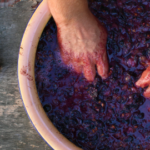Eiswein, often known as Ice Wine outside Germany and Austria, is not simply a sweet treat to enjoy with your dessert. It is a highly collectible German wine made from frozen grapes (typically Riesling). Popular vintages are highly sought after and can command a hefty price tag. So, other than being sweet, what makes these wines unique? Ever wondered why Eiswein is different from other wines? Didn’t know whether you should try it? Well, consider these facts about this palate-pleasing libation.
Why Is it Hard to Make Eiswein?
It takes a very specific type of climate to produce Eiswein. The summer days must be warm enough to support a bountiful harvest of grapes. But, an early winter frost is necessary to freeze them before they linger too long on the vine. Eiswein is typically produced in the Rheingau, Pfalz, Rheinhessen, and Mosel regions of Germany. It is a tricky process. The grapes must stay on the vine much longer than they do for a typical harvest season. Growers need to protect them from disease, rot, insects, and birds while they await the winter freeze.
As soon as temps hit 19 degrees Fahrenheit or lower, the winery must gather its staff and pluck all the grapes from the vine early in the morning before sunrise. The hilly terrain in which they grow is covered with shale, which only adds to the difficulty of the harvest, and in the old days, many winemakers didn’t have presses that were strong enough to crush the frozen grapes. This is still difficult to do, which produces a low yield, and bottles are coveted the world over.
Why All the Fuss?
With such a complicated growing and harvest process, many people wonder why winemakers don’t simply freeze the grapes to make the wine. The reason is that nature needs to take its course. The grapes need to remain on the vine long enough for extra sugars to develop within them. Then on that first frosty night, when the cold air moves in, the water content in each grape freezes, but its sugars do not. As the frozen grapes are gathered and immediately pressed, the sugar and other solids are used to make the wine, as the frozen water is pressed out. The point is to get as much flavor as possible into the wine. The flavor is in the solids and sugars, not in the water.
The team working for the winery also must work fast. The grape’s cell walls are broken down when they freeze. So, they begin to rot as soon as they start to thaw. If this happens too quickly, all the work is for naught, and the wine is worthless.
Wine may or may not be your thing, but Eiswein falls into a category all its own. If you are looking to try something new or add an element you have been missing from your liquor cabinet or wine cellar, visit Payless Liquors today and browse our selection.













